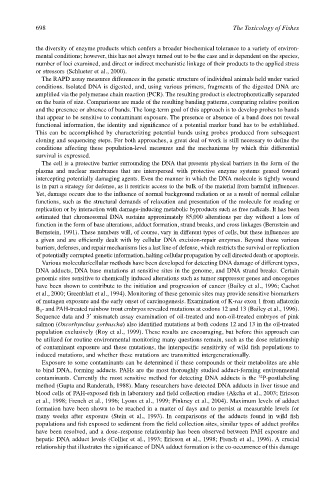Page 718 - The Toxicology of Fishes
P. 718
698 The Toxicology of Fishes
the diversity of enzyme products which confers a broader biochemical tolerance to a variety of environ-
mental conditions; however, this has not always turned out to be the case and is dependent on the species,
number of loci examined, and direct or indirect mechanistic linkage of their products to the applied stress
or stressors (Schlueter et al., 2000).
The RAPD assay measures differences in the genetic structure of individual animals held under varied
conditions. Isolated DNA is digested, and, using various primers, fragments of the digested DNA are
amplified via the polymerase chain reaction (PCR). The resulting product is electrophoretically separated
on the basis of size. Comparisons are made of the resulting banding patterns, comparing relative position
and the presence or absence of bands. The long-term goal of this approach is to develop probes to bands
that appear to be sensitive to contaminant exposure. The presence or absence of a band does not reveal
functional information, the identity and significance of a potential marker band has to be established.
This can be accomplished by characterizing potential bands using probes produced from subsequent
cloning and sequencing steps. For both approaches, a great deal of work is still necessary to define the
conditions affecting these population-level measures and the mechanisms by which this differential
survival is expressed.
The cell is a protective barrier surrounding the DNA that presents physical barriers in the form of the
plasma and nuclear membranes that are interspersed with protective enzyme systems geared toward
intercepting potentially damaging agents. Even the manner in which the DNA molecule is tightly wound
is in part a strategy for defense, as it restricts access to the bulk of the material from harmful influences.
Yet, damage occurs due to the influence of normal background radiation or as a result of normal cellular
functions, such as the structural demands of relaxation and presentation of the molecule for reading or
replication or by interaction with damage-inducing metabolic byproducts such as free radicals. It has been
estimated that chromosomal DNA sustains approximately 85,000 alterations per day without a loss of
function in the form of base alterations, adduct formation, strand breaks, and cross linkages (Bernstein and
Bernstein, 1991). These numbers will, of course, vary in different types of cells, but these influences are
a given and are efficiently dealt with by cellular DNA excision-repair enzymes. Beyond these various
barriers, defenses, and repair mechanisms lies a last line of defense, which restricts the survival or replication
of potentially corrupted genetic information, halting cellular propagation by cell directed death or apoptosis.
Various molecular/cellular methods have been developed for detecting DNA damage of different types,
DNA adducts, DNA base mutations at sensitive sites in the genome, and DNA strand breaks. Certain
genomic sites sensitive to chemically induced alterations such as tumor suppressor genes and oncogenes
have been shown to contribute to the initiation and progression of cancer (Bailey et al., 1996; Cachot
et al., 2000; Greenblatt et al., 1994). Monitoring of these genomic sites may provide sensitive biomarkers
of mutagen exposure and the early onset of carcinogenesis. Examination of K-ras exon 1 from aflatoxin
B - and PAH-treated rainbow trout embryos revealed mutations at codons 12 and 13 (Bailey et al., 1996).
1
Sequence data and 3′ mismatch assay examination of oil-treated and non-oil-treated embryos of pink
salmon (Oncorhynchus gorbuscha) also identified mutations at both codons 12 and 13 in the oil-treated
population exclusively (Roy et al., 1999). These results are encouraging, but before this approach can
be utilized for routine environmental monitoring many questions remain, such as the dose relationship
of contaminant exposure and these mutations, the interspecific sensitivity of wild fish populations to
induced mutations, and whether these mutations are transmitted intergenerationally.
Exposure to some contaminants can be determined if these compounds or their metabolites are able
to bind DNA, forming adducts. PAHs are the most thoroughly studied adduct-forming environmental
contaminants. Currently the most sensitive method for detecting DNA adducts is the P-postlabeling
32
method (Gupta and Randerath, 1988). Many researchers have detected DNA adducts in liver tissue and
blood cells of PAH-exposed fish in laboratory and field collection studies (Akcha et al., 2003; Ericson
et al., 1998; French et al., 1996; Lyons et al., 1999; Pinkney et al., 2004). Maximum levels of adduct
formation have been shown to be reached in a matter of days and to persist at measurable levels for
many weeks after exposure (Stein et al., 1993). In comparisons of the adducts found in wild fish
populations and fish exposed to sediment from the field collection sites, similar types of adduct profiles
have been resolved, and a dose–response relationship has been observed between PAH exposure and
hepatic DNA adduct levels (Collier et al., 1993; Ericson et al., 1998; French et al., 1996). A crucial
relationship that illustrates the significance of DNA adduct formation is the co-occurrence of this damage

